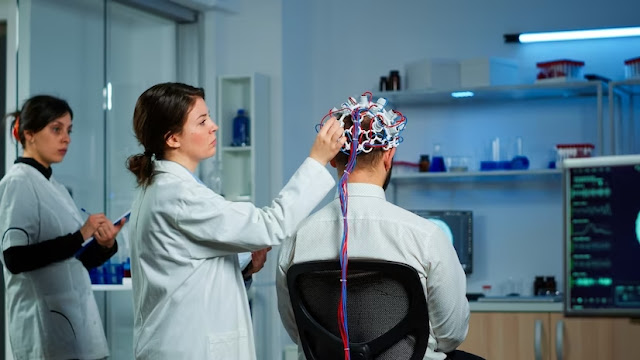What is Neuro Electro Physiology: A Comprehensive Guide
Neuro electrophysiology is the study of the electrical activity of the brain and nervous system. It involves the measurement and analysis of the electrical signals generated by neurons, which are the basic building blocks of the nervous system. In this article, we will explore the fundamentals of neuro electro physiology, including its history, methods, applications, and future prospects.
History of Neuro Electro Physiology
The origins of neuro electro physiology can be traced back to the late 19th century when Italian physician and physiologist Luigi Galvani discovered that electrical stimulation could cause muscle contractions in frogs. This led to the development of electrophysiology, which focuses on the electrical properties of cells and tissues. In the early 20th century, German physiologist Hans Berger became the first person to record the electrical activity of the human brain, using an electroencephalogram (EEG). This breakthrough paved the way for the study of neuro-electrophysiology.
 |
| What is Neuro Electro Physiology |
Methods in Neuro Electro Physiology
There are several methods used in neuro electro physiology to measure and analyze the electrical activity of the brain and nervous system. These include:
Electroencephalography (EEG)
EEG is a non-invasive technique that records the electrical activity of the brain using electrodes placed on the scalp. It is commonly used in clinical settings to diagnose and monitor neurological disorders such as epilepsy and sleep disorders.
Magnetoencephalography (MEG)
MEG is a non-invasive technique that measures the magnetic fields generated by the electrical activity of the brain. It provides high temporal and spatial resolution and is useful in studying brain function and cognitive processes.
Electrocorticography (ECoG)
ECoG involves placing electrodes directly on the surface of the brain to record its electrical activity. It is used in clinical settings to map brain function before surgery and in research to study brain function and cognitive processes.
Intracranial Electrophysiology
Intracranial electrophysiology involves placing electrodes inside the brain to record its electrical activity. This is an invasive technique that is used in research and in clinical settings to diagnose and treat neurological disorders.
Applications of Neuro Electro Physiology
Neuro electro physiology has numerous applications in both clinical and research settings. Some of the major applications include:
Diagnosis and Treatment of Neurological Disorders
Neuro electro physiology is used in clinical settings to diagnose and treat neurological disorders such as epilepsy, Parkinson's disease, and Alzheimer's disease.
Study of Brain Function and Cognitive Processes
Neuro electro physiology is used in research to study brain function and cognitive processes such as attention, memory, and perception.
Brain-Computer Interfaces
Neuro electro physiology is used in the development of brain-computer interfaces, which enable communication between the brain and external devices. This technology has potential applications in prosthetics, assistive devices, and virtual reality.
Future Prospects
The field of neuro electro physiology is rapidly advancing, with new technologies and techniques being developed to study the brain and nervous system. Some of the key areas of research include:
Brain-Computer Interfaces
Research in brain-computer interfaces is focused on developing more advanced and reliable technology for communication between the brain and external devices.
Neuromodulation
Neuromodulation involves the use of electrical or magnetic stimulation to modulate the activity of the brain and nervous system. It has potential applications in the treatment of neurological disorders such as depression, chronic pain, and Parkinson's disease.
Neuroprosthetics
Neuroprosthetics involve the development of devices that can restore lost function to the nervous system. This technology has potential applications in the treatment of paralysis, blindness, and deafness.
Conclusion
Neuro electro physiology is a fascinating field that has revolutionized our understanding of the brain and nervous system. The study of the electrical activity of neurons has provided insight into brain function and cognitive processes and has led to the development of new diagnostic and therapeutic tools for neurological disorders. With continued advancements in technology and research, the future of neuro electro physiology holds great promise for improving our understanding of the brain and developing new treatments for neurological disorders.
FAQs
- What is the difference between EEG and MEG?
EEG measures the electrical activity of the brain using electrodes placed on the scalp, while MEG measures the magnetic fields generated by this activity. MEG provides higher spatial resolution but lower temporal resolution compared to EEG.
- Is intracranial electrophysiology safe?
Intracranial electrophysiology is an invasive technique that carries risks such as bleeding, infection, and damage to brain tissue. However, it is considered safe when performed by experienced neurosurgeons.
- Can neuro electro physiology help in the treatment of depression?
Neuromodulation, a technique used in neuro electro physiology, has shown promise in the treatment of depression. It involves the use of electrical or magnetic stimulation to modulate the activity of the brain and nervous system.
- How can neuro electro physiology help in the development of prosthetics?
Neuroprosthetics involve the development of devices that can restore lost function to the nervous system. Neuro electrophysiology is used to study the electrical activity of the nervous system and develop devices that can communicate with the brain to restore lost function.
- What are the potential risks of brain-computer interfaces?
Brain-computer interfaces are a relatively new technology, and there is still much research to be done on their long-term safety and efficacy. Some potential risks include infection, bleeding, and damage to brain tissue.
